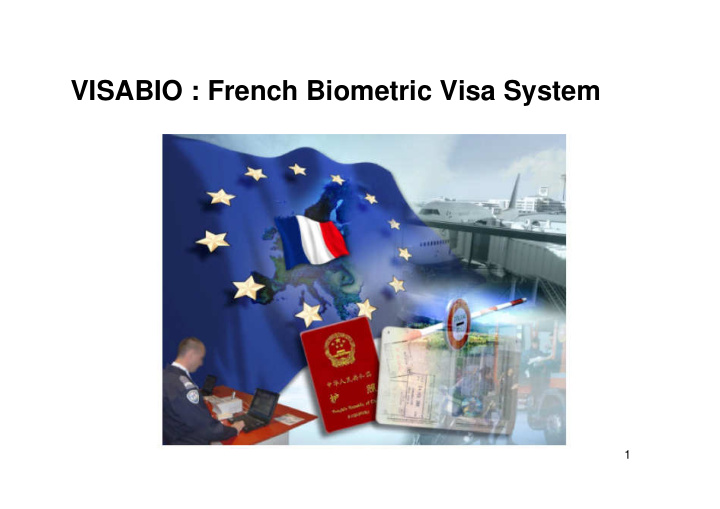



VISABIO : French Biometric Visa System 1
CONTENTS • Lessons learnt from the BIODEV 1 Pilot Project • The VISABIO project : Perimeter, schedule, challenges • Toward the future : connecting to the VIS project and automates at the border, how to reduce the error rate of biometric comparison 2
Lessons learnt from the BIODEV 1 Pilot Project • A few facts : – First biometric visa issued and controlled in march 2005 – More than 550,000 travellers enrolled – 57 consulates equipped – Controls performed daily 3
Consulates : fingerprint capture French consulate of France in Minsk French consulate of France in Bamako (Belarus) 4 (Mali)
Lessons learnt from the BIODEV 1 Pilot Project • Good acceptability by the travellers and the foreign authorities • Constraint of a change management structure for the Border police agents • Feasability of the data capture in the consulates • Criticity of the points of entry: fluidity is not only a key issue, but the main one 5
The VISABIO project • VISABIO is first of all, a national system to process and store the biometric visas, including an AFIS • Its main purposes are: – Fight against illegal immigration – Fight against terrorism – Preparation of the connection to the european VIS system • Five French ministries are involved – Immigration and integration – Foreign affairs – Interior – Defence/ gendarmerie – Finance/customs 6
The VISABIO project: main features • AFIS 15M records • More than 2,000 capture stations and 5,000 workstations • Integrated border control workstation • Simulator for all staff in charge of biometric control • High level of data protection (privacy) • Integration within the technical environment • VIS compatible interface design 7
The VISABIO project: schedule • Spring 2006: call for tender • November 2006: contract notified to SAGEM security • 2007: functional and technical specifications • T1 2008: tests on the central system, migration of BIODEV data and specification of new generation integrated border control and territory control • T2 2008: central system operational • T3 2008: new generation of border control stations • T4 2008: upgrade of the Foreign Affairs system and connection to the VIS (with NS-VIS and VIS simulator) • June 2009: connecting VIS 8
The VISABIO project: general architecture 9
The VISABIO project: human factors • A view of the of the border control station screen, able to process all types of travel documents 10
The VISABIO project: a modular approach 11
Toward the future: connection to e-gates • Growing traffic and peaks (e.g. Airbus A380) • E-Gates allow a better management of the Police resource and reduce the average time to cross the border • Project « PARAFES »: equipment of main airports and harbours with automatic gates for UE residents 12
Toward the future: multimodal biometrics to reduce the error rate of fingerprint verification • Observation: 1,5% of people controlled at the first border line are not authenticated and must be controlled at the second border line for a strong authentication [10: 10] or an identification: – Among these persons, some have been rejected wrongly. A second biometric data [1:1] should confirm or not the no hit. • When a visa applicant is stored in the system, the AFIS controls if this applicant has a unique identity: – If there is a hit with another identity, a comparison with a second biometric data [1:1 would confirm the hit and avoid a manual expertise. 13
Recommend
More recommend